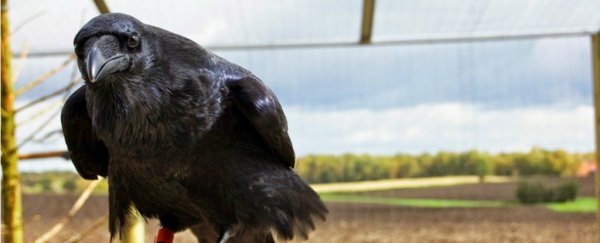Just when we thought corvids couldn't get any smarter, new research shows that ravens are just as capable of planning ahead of time as humans and apes. They can also barter and use tools better than apes, and display greater self-control than four-year-old children.
The new findings show that planning for future events may have evolved in these birds after they and mammals shared a common ancestor over 300 million years ago.
"Our results show that ravens combine a set of skills to solve a range of tasks in a similar way to apes," Mathias Osvath, lead author from the University of Lund in Sweden, told ScienceAlert.
Osvath says the team replicated the same experiments carried out on apes in a previous study, and found that ravens are more successful at using tools and bartering, even though they don't have a predisposition to such skills.
It's no secret that the corvid family, which includes crows and ravens, have a solid reputation as the brains trust of the avian world. When they're not using traffic to crack open nuts, they're solving water displacement puzzles better than a five-year-old kid.
And it's not all about winning at problem-solving games. When it comes to meal planning, corvids like the Western scrub-jay (Aphelocoma californica) can prepare breakfast for the following morning. To avoid going hungry, these brainy birds store specific types of food in places where it isn't readily available.
Ravens (Corvus corax) have also shown glimmers of food hoarding like their scrub-jay cousins. But until now, researchers have assumed that this behaviour was because of a specific adaptation to food storing rather than a broad set of planning skills similar to humans and apes.
To take a closer look, the team put the birds through a series of exercises that were originally carried out on great apes.
The first experiment measured whether the birds could plan for an event down the track in intervals of 15 minutes.
After training the ravens to use a specific tool to open a box, the team took the tool away from the birds for an hour. When the researchers returned, they presented each raven with a selection of objects, including the box-opening tool.
Once 15 minutes had passed, the puzzle box was brought back in containing a reward. In most cases, the ravens chose the correct tool and used it to unlock the box with a success rate of 86 percent.
Taking the exercise further, the researchers extended the waiting time to 17 hours. Once again, the ravens smashed the tool selecting test with a score of 89 percent.
Next, the researchers put the ravens' bartering skills to the test. To begin the game, the ravens had to pick out the correct food-swapping token from a selection of objects.
The catch was that the food reward wasn't available until the next day. In order for the ravens to receive their promised reward, they needed to stash their chosen token away to use later.
Even though they don't use tools in the wild, results showed that the ravens bartering skills were more on point than chimpanzees, bonobos and orangutans. The birds' tool-handling skills were also on level with great apes.
The team also tested whether ravens were capable of self-control.
This time, the birds were presented with a selection of box-opening tools, exchange tokens and distraction objects. The team also offered an instant reward in addition to the reward in the box. In this exercise, the ravens were only allowed to select one item overall.
Despite the temptation of an immediate reward, the ravens preferred to hold out for the better quality reward inside the box, opting for the tool or token 70 percent of the time. In this test, ravens outperform both apes and four-year-old children.
Apart from showing how smart ravens are, the results offer clues about how cognitive abilities may have evolved since birds and mammals shared a common ancestor 320 million years ago.
"What I find most interesting is that it's not just one skill that has evolved here, but a combination of skills," Osvath told ScienceAlert. "It's fascinating that evolution can repeat the same skills and how they are put together."
The research was published in Science.
